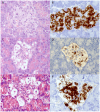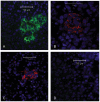Lack of evidence for a role of islet autoimmunity in the aetiology of canine diabetes mellitus
- PMID: 25153886
- PMCID: PMC4143278
- DOI: 10.1371/journal.pone.0105473
Lack of evidence for a role of islet autoimmunity in the aetiology of canine diabetes mellitus
Abstract
Aims/hypothesis: Diabetes mellitus is one of the most common endocrine disorders in dogs and is commonly proposed to be of autoimmune origin. Although the clinical presentation of human type 1 diabetes (T1D) and canine diabetes are similar, the aetiologies may differ. The aim of this study was to investigate if autoimmune aetiology resembling human T1D is as prevalent in dogs as previously reported.
Methods: Sera from 121 diabetic dogs representing 40 different breeds were tested for islet cell antibodies (ICA) and GAD65 autoantibodies (GADA) and compared with sera from 133 healthy dogs. ICA was detected by indirect immunofluorescence using both canine and human frozen sections. GADA was detected by in vitro transcription and translation (ITT) of human and canine GAD65, followed by immune precipitation. Sections of pancreata from five diabetic dogs and two control dogs were examined histopathologically including immunostaining for insulin, glucagon, somatostatin and pancreas polypeptide.
Results: None of the canine sera analysed tested positive for ICA on sections of frozen canine or human ICA pancreas. However, serum from one diabetic dog was weakly positive in the canine GADA assay and serum from one healthy dog was weakly positive in the human GADA assay. Histopathology showed marked degenerative changes in endocrine islets, including vacuolisation and variable loss of immune-staining for insulin. No sign of inflammation was noted.
Conclusions/interpretations: Contrary to previous observations, based on results from tests for humoral autoreactivity towards islet proteins using four different assays, and histopathological examinations, we do not find any support for an islet autoimmune aetiology in canine diabetes mellitus.
Conflict of interest statement
Figures



References
-
- Fall T, Hamlin HH, Hedhammar A, Kampe O, Egenvall A (2007) Diabetes mellitus in a population of 180,000 insured dogs: incidence, survival, and breed distribution. J Vet Intern Med 21: 1209–1216. - PubMed
-
- Lindblad-Toh K, Wade CM, Mikkelsen TS, Karlsson EK, Jaffe DB, et al. (2005) Genome sequence, comparative analysis and haplotype structure of the domestic dog. Nature 438: 803–819. - PubMed
-
- Catchpole B, Ristic JM, Fleeman LM, Davison LJ (2005) Canine diabetes mellitus: can old dogs teach us new tricks? Diabetologia 48: 1948–1956. - PubMed
-
- Rand JS, Fleeman LM, Farrow HA, Appleton DJ, Lederer R (2004) Canine and feline diabetes mellitus: nature or nurture? J Nutr 134: 2072S–2080S. - PubMed
-
- Fall T, Hedhammar A, Wallberg A, Fall N, Ahlgren KM, et al. (2010) Diabetes mellitus in elkhounds is associated with diestrus and pregnancy. J Vet Intern Med 24: 1322–1328. - PubMed
Publication types
MeSH terms
Substances
LinkOut - more resources
Full Text Sources
Other Literature Sources
Medical
Miscellaneous

